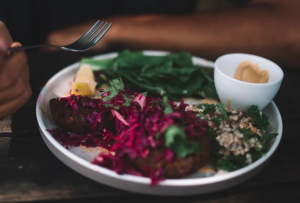Nutrition For Conception

Nutrition is the first of my four foundations for a healthy pregnancy and birth.
A balanced diet that includes a healthy balance of protein, grains, fruit, and vegetables is key. It is key to having healthy nutrient levels for the early development of the embryo. The other three key components are exercise, stress reduction, and body mechanics which we will address in a later blog.
Remove poor choices from your life as you prepare for conception. Habits such as drinking, or smoking must be avoided to allow for optimal health and development of the child during pregnancy and after birth. Caffeine should be reduced. And a general avoidance of unhealthy food choices such as soda, sweets, and fried snacks.
Good habits should include taking a daily prenatal vitamin to make up for the nutrients missing. Even if you are consuming healthy foods daily, you can miss out on key nutrients. A daily whole food prenatal vitamin ideally started at least three months before conception can help fill in any gaps and avoid any preventable complications.
Adequate nutrition during your preconception and prenatal periods are important for your health and your developing baby. Achieving a healthy weight either by gaining or losing weight may facilitate conception, prevent birth defects, as well as reduce pregnancy complications such as gestational diabetes and pre-eclampsia.
How much you need to eat is dependent on your health and exercise level. When planning for conception you should be focusing on quality foods and not quantity. Even when you are pregnant you are NOT eating for two. Let’s dispel that myth. this is not a time to spoil yourself or eat without intention. Instead in pregnancy, you will be eating an additional 250-300 calories a day for a single pregnancy and more for twins or triplets.
A balanced diet:
When planning for conception or pregnancy, you look at the food choices on your plate at every meal. Your plate should represent a variety of colors like a mini rainbow on your plate.
- Whole grains: Bread, cereals, pasta, and brown rice.
- Fruits: All types of fruits, fresh and frozen without added sugar.
- Vegetables: Eat a variety of colorful vegetables, fresh, frozen, or canned with no added salt. Raw sprouts should be avoided.
- Lean protein: Choose lean protein from meat, poultry, fish, eggs, beans, nuts, and soy products. Pregnant women should avoid eating mercury-rich fish. Also, deli meats and hot dogs should be reheated if consumed.
- Low-fat or fat-free dairy: This includes milk, cheese, and yogurt. Unpasteurized milk and some soft cheeses that are made from unpasteurized milk should also be avoided.
- Healthful fats: Vegetable oils including canola, peanut, and olive oil are good choices.
Avoid extra calories from added sugar and fats, which can lead to unhealthy weight gain.

When you look at your food choices on your plate, you should have a variety of colors! Each and every color is associated with different micro and macronutrient that feeds a healthy pregnancy and baby. When your plate is all one color- you’re missing out on nutrients you need. Consider this example: if you are having chicken, white potato, and cauliflower- your food choices are all pale. But if you switch out the sweet potato for the white potato and broccoli for the cauliflower you now have a colorful plate! Add in some strawberries and blueberries and the whole rainbow is represented.
Fine-tuning your eating habits to ensure you are receiving adequate nutrition for the health of you and your baby is key. Healthy eating during pregnancy is critical for a healthy pregnancy and baby!
Learn more about prenatal vitamins here.
